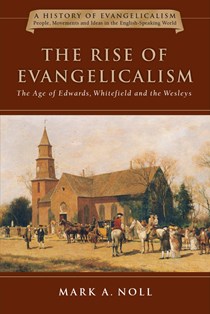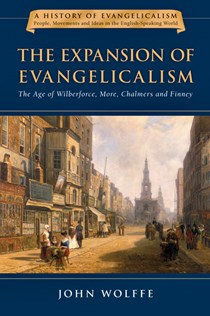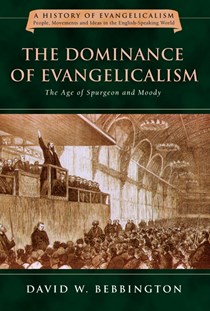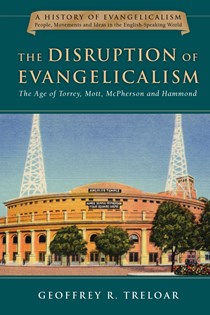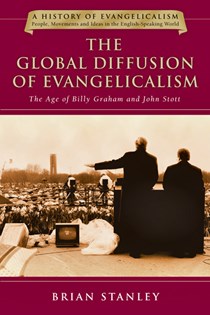Evangelicalism in the Early Twenty-First Century
By Mark A. Noll
The word “evangelical” seems to be in trouble—but for two different reasons. In the rough and tumble world of American politics, the label is now often used simply to designate the most active religious supporters of President Donald Trump. By contrast, in the rarified world of professional scholarship, academics now sometimes treat it as a term with so much ambiguity, fluidity, and imprecision that it cannot meaningfully designate any single group of Christians. For both of these contemporary opinions, there are some admittedly good reasons. Yet stepping back for a longer view historically and a wider view internationally opens up another possibility: maybe the scholars are too fussy and the pundits too short-sighted.
My own interest in this issue is not merely academic since I serve as coeditor of the five-volume History of Evangelicalism Series by IVP. That experience leaves me with a personal stake in the question, but has also provided a number of unusually helpful insights. The five authors from three countries (or four if you consider Scotland as separate from England) explore developments in the British Isles (Ireland, Wales, and Scotland as well as England), North America (Canada as well as the U.S.), and the settler societies of the Caribbean, Australia, New Zealand, and South Africa where evangelicalism out of Britain has exerted an enduring influence. To say the least, the series reveals extreme diversity among Protestant Christians who called themselves evangelicals or who have been so regarded by historical consensus. Yet commonalities of not only belief and practice, but also sentiment and instinct, are often as obvious as the diversity. The rewarding chance to work on the series has, in turn, provided a propitious angle from which to comment especially on questions of diversity, continuity, incoherence, and coherence raised by contemporary debates over the meaning of "evangelica" and "evangelicalism." It also points to a conclusion that the most significant present-day questions about the history of evangelicalism do not arise from American political turmoil but from the shape of world Christianity as a whole.
Does "evangelical" mean anything at all?
In the contemporary American narrative promoted by the media’s obsession with partisan politics, evangelicals are the white conservative voters who have gone from solidly supporting the Republican party (especially Ronald Reagan and George W. Bush) to giving even more overwhelming support to the nationalistic populism of Donald Trump. A big recent book by Pulitzer Prize-winning author Frances Fitzgerald presents this narrative in carefully researched detail. Entitled The Evangelicals: The Struggle to Shape America, it implies that its plot line—with three-fourths of its over 600 pages devoted to the white Christian Right—captures the essence of evangelicalism.1
Neither this book nor the many other accounts that echo it are foolish. With 80% of white evangelicals, as identified by pollsters, voting for Donald Trump in 2016, and a similar percentage affirming their approval of his presidency to date, it is obvious why accounting for white evangelical support of right-wing nationalism remains a prominent feature of American political analysis.
Yet if the identification of white American evangelicals as a right-wing political force makes considerable sense, the limitations of that identification are just as obvious. In a careful review of Frances Fitzgerald’s book, Randall Balmer of Dartmouth College points out that in some American eras, evangelicals included as many social progressives as conservatives.2 Before the Civil War, the nation’s best-known evangelist, Charles Finney, and several of his converts like Theodore Dwight Weld led the struggle against slavery. After the Civil War, the firmly evangelical Frances Willard guided the Women’s Christian Temperance Union in its fight to protect women and children from abuses fueled by alcohol. In our era when evangelicals can be confused for the Republican Party at prayer, it is worth remembering the situation from little more than a century ago. For more than two decades, William Jennings Bryan, three-time Democratic candidate for president, was the United States’ best known evangelical layman and also one of the nation’s most ardent advocates for the income tax, female suffrage, and peaceful international arbitration as a substitute for war. Even in the recent past, Randall Balmer points out that international efforts for peace in the Middle East and elsewhere were led by Jimmy Carter, a Southern Baptist Sunday School teacher—a point Balmer has developed in a full-length study of the United States’ 39th president.3
Other evidence of the same sort abounds. A recent book by Heath Carter of Valparaiso University entitled Union Made examines labor and industry between the Civil War and World War I.4 It documents fulsomely the many Bible-believing, church-going, and Christ-honoring union organizers who fought for workers’ rights—against, to be sure, Bible-believing, church-going, and Christ-honoring captains of industry. In the present, the record of the Salvation Army, World Vision, the International Justice Mission, and other such organizations shows that white evangelicals have never constituted a monolithic political force. Observers like Balmer and Carter do not deny that evangelicals have often contributed substantially to conservative political causes, but they are certainly correct that throughout American history “evangelical” has always meant more than the Right Wing.
Careful historians perform a much-needed service by complicating the story of how evangelical motives underlie evangelical social and political action. The evangelical stress on personal conversion and personal moral responsibility has, in fact, often been aligned with worries about Big Government and insistence on individual choice as the key to social betterment. But those same evangelical convictions have also spurred a wide variety of creative plans for collective reform as well.
The evangelical stress on personal conversion and personal moral responsibility has, in fact, often been aligned with worries about Big Government and insistence on individual choice as the key to social betterment. But those same evangelical convictions have also spurred a wide variety of creative plans for collective reform as well.
The conceptual challenge from scholars poses a more basic question than the simplistic equation of evangelicalism and right-wing politics. This challenge focuses on the religious meaning of the term, which is proper since evangelicals have always insisted that religion is their primary concern. But how should that primary concern be defined?
In 1989 my coeditor for the IVP series, David Bebbington (University of Stirling, Scotland), provided a succinct definition in his book, Evangelicalism in Modern Britain, that has been widely referenced.5 The definition identifies evangelicalism as a form of Protestantism with four distinct emphases:
- conversion, or “the belief that lives need to be changed”;
- the Bible, or “the belief that all spiritual truth is to be found in its pages”;
- activism, or the dedication of all believers, especially the laity, to lives of service for God, especially in sharing the Christian message and taking that message far and near;
- and crucicentrism, or the conviction that Christ’s death on the cross provided atonement for sin and reconciliation between sinful humanity and a holy God.
While many, both scholars and popular writers, have employed this definition to good effect, others have pointed out difficulties. Most obvious in an American context are divisions created by race. Along with many white Protestant groups that are marked by these four characteristics, so too have many African Americans. Yet the American embrace of slavery, followed by culturally enforced segregation, means that whites and blacks who share these religious emphases share very little else. An evangelicalism that includes both blacks and whites might make sense in very narrow religious terms, but far less in the actual outworking of American history.
A development of only the last half century also complicates the picture. The differences between Roman Catholics and Protestants, especially evangelical Protestants, once was as clear-cut as possible. But no longer. Almost all surveys focused on religious commitments now turn up at least some Catholics who in belief and practice look an awful lot like evangelicals. The once unbridgeable chasm is now being bridged.
The differences between Roman Catholics and Protestants, especially evangelical Protestants, once was as clear-cut as possible. But no longer. Almost all surveys focused on religious commitments now turn up at least some Catholics who in belief and practice look an awful lot like evangelicals. The once unbridgeable chasm is now being bridged.
A broader historical challenge has recently come from Linford Fisher of Brown University in a substantial article documenting that “evangelical” has often meant less, and sometimes more, than the Bebbington definition.6 From the time of the Reformation and for several centuries, Fisher shows that the word usually meant simply “Protestant” or, almost as frequently, “anti-Catholic.” During the eighteenth-century revivals associated with George Whitefield, Jonathan Edwards, and John Wesley, “awakened” believers in Britain and America did not use the word too frequently. When they did, it meant “true” or “real” religion as opposed to nominal or only formal religious adherence. Fisher also shows that after World War II, former fundamentalists in the United States endorsed the word as they sought a less combative, more irenic term to describe their orthodox theology and their desire to re-engage with society. Organizations like the National Association of Evangelicals and the wide-ranging activities of Billy Graham popularized the word. In the process some Pentecostals, Lutherans, Mennonites, Christian Reformed, and others who had not been associated with the main body of America’s earlier “evangelical Protestants” were now glad to join in using it to describe themselves. At the same time other Protestants who had thought of themselves as evangelicals began to avoid the word as designating something too close to fundamentalism.
In more recent days several authors have highlighted further indications of uncertainty. In a thoughtful recent consideration of “Billy Graham’s Legacy,” Margaret Bendroth points out that self-described evangelicals have a long history of disagreeing among themselves on issues like biblical inerrancy, women’s ordination, and homosexuality. But now such disputes seem to have reached a deeper level. She identifies of the publication in 2011 of Rob Bell’s book, Love Wins, which addressed the question whether all humans will ultimately be redeemed, as particularly telling. Bell’s suggestion that they would be saved generated intense push-back from others, but also some support—and all from within the camps usually designated evangelical.7 The questions raised by Fisher, Bendroth, and others concern whether the word “evangelical” has been applied with sufficient consistency to make it worthwhile as a category of analysis.
The international picture only adds more ambiguity. A wider lens that takes in the world beyond the United States reveals the same political diversity that characterizes the American past. As documented in the five-volume series from InterVarsity Press, modern evangelicalism in its early decades included many in the American colonies who firmly supported American independence, quite a few Presbyterians and Congregationalists in England who agreed, but also significant English leaders like John and Charles Wesley who considered independence both anti-biblical (they cited Romans 13) and hypocritical (they meant slave owners howling about violations of their “liberty”). The later campaign against slavery in the British empire by William Wilberforce and his associates remains the best recognized evangelical mobilization for human liberation—though less attention has been paid to the conservative positions on domestic political questions that the Wilberforce circle adopted. During the second half of the nineteenth century, Primitive Methodists in England led in the formation of agricultural trade unions, and some of the original organizers of the Labor Party actively supported the evangelism of D. L. Moody. Throughout the English-speaking world, evangelicals joined those who supported unionization, wanted more government support for education and medical care, and actively campaigned for social welfare. Individuals like Samuel Keeble in England, Joseph Branch in Wales, and W. G. Spence in Australia represented large evangelical constituencies in these efforts, even as other evangelicals spoke out against those who pushed for progressive social causes.
More generally, the changing shape of world Christianity puts contemporary American debates into an appropriately broader context. The 2001 edition of David Barrett’s World Christian Encyclopedia identified 210 million Christian believers as “evangelicals” worldwide, with another 510 million as “Pentecostal, Neo-Pentecostal, or Charismatic.” Of those numbers only 64 million evangelicals lived in Europe or North America, only 116 million of the Pentecostal-charismatic total. Full-scale interpretation in a recent book by Mark Hutchinson and John Wolffe, A Short History of Global Evangelicalism, and a comprehensive reference volume edited by Brian Stiller, Evangelicals Around the World, flesh out Barrett’s statistical picture.8 The two books describe an increasingly diverse, but still recognizable worldwide network linked by shared religious convictions. Together they indicate that the politics and preoccupations of the contemporary American media should not be allowed to dictate what “evangelical” means.
The changing shape of world Christianity puts contemporary American debates into an appropriately broader context.
Yet for some thoughtful individuals who in former days rested comfortably with the evangelical label, precisely these contemporary controversies have ruined the term beyond repair. Jay Green, the immediate past president of the evangelical-founded Conference on Faith and History, may be one of those. In his analysis, a kind of intellectual political energy had been responsible for the founding sense of purpose that in the mid-1960s brought the Conference into existence. But now, with a different “politics of evangelical identity” at work in American society at large, Green despairs: “It is simply no longer the case that evangelicalism functions as an expression of Christian faith capable of sponsoring either serious intellectual engagement or genuine cultural renewal.”9
But others say, “not so fast.” Molly Worthen of the University of North Carolina has insisted that “evangelical” remains a viable term when considered as a “shared conversation” about how to reconcile faith and reason, what true salvation means, and how private faith relates to modern secular life. In turn, Worthen can conclude about the contemporary United States that “the religious right is really the product of a civil war within evangelicalism. It represents the political efforts of a fairly narrow slice out of the myriad evangelical traditions that have been active in American and Western history.”10 If she is correct, then closer attention to that history should help answer questions about the uncertainties of the present.
Evangelical identity in the English-speaking world
The History of Evangelicalism Series shares some of Molly Worthen’s optimism about the viability of the term, but from a broader angle (the English-speaking world) and a longer period of time (the early eighteenth century to the start of the new millennium). These five volumes carry a mostly coherent story from the early 1700s through the twentieth century, but not because all of the many individuals and organizations identified as evangelicals stood shoulder to shoulder on all questions of Christian belief and practice. Instead, coherence comes from two overarching realities. The books, first, find it an easy matter to trace multiple connections descending historically from the colonial Great Awakening and Britain’s Evangelical Revival. Second, they document a clear historical trajectory marked by serious commitment to the authority of Scripture, the saving work of Christ’s death and resurrection, the possibility of lives revived and redirected by the converting power of the Holy Spirit, and the necessity for all believers to put their private faith into public action. To put it differently, the books hang together because they record a continuous history of English-speaking Protestant Christians defined by an evolving, but connected investment in the commitments specified by David Bebbington. Brief attention to the five IVP volumes brings particular perspective to the dialectic between diversity and cohesion in evangelical history.
Brief attention to the five IVP volumes brings particular perspective to the dialectic between diversity and cohesion in evangelical history.
For the nearly two centuries treated by the first three books in the series, some questions about the boundaries of evangelical identity are easy to answer. Evangelicalism from the early eighteenth century to about 1900 can be viewed as a shared conversation that was more than a conversation. Evangelicals in the British homeland, the American colonies, and then in British settler colonies could be identified as the most vocal anti-Catholics of their era because they believed that Catholicism undercut the dynamic of personal faith required for “true religion.” The many disagreements in their shared conversation concerned theology (especially Calvinism versus Arminianism and then the meaning of baptism), church order (especially state-church Anglicans and Scottish Presbyterians versus those who believed in the separation of church and state), and orientation to politics and social reform (with competition among individualistic, voluntary, paternalistic, and government-directed positions).
The sharpest division arose over whether slave-holding ruled out evangelical fellowship and cooperation. The contribution by John Wolffe (Open University, U.K.), The Expansion of Evangelicalism: The Age of Wilberforce, More, Chalmers and Finney (2006), explains in detail how plans for a trans-national Evangelical Alliance in the 1840s enlisted a wide range of British, North America, and a few continental Protestants. When in 1846 representatives gathered in London, they agreed on the authority of the Bible, the life-changing work of the Holy Spirit, the atonement won by Christ on the cross, and more. Yet because these evangelicals disagreed over whether slave holders could join the Alliance—and because Americans were offended that this issue sidelined their objection to state churches—, the Alliance never became a vigorous international organization.
Nevertheless, within limits, evangelicals throughout the period were easily identified by networks of preachers, prayer meetings, publishing efforts, and personal witnessing that reached back to the eighteenth-century revivals. Diversity within these networks—over theology, denomination, education, geography, class, and race—did threaten disruption. But deeply shared attitudes pushed toward cohesion. In my contribution to the series—The Rise of Evangelicalism: The Age of Edwards, Whitefield, and the Wesleys (2003)—I draw attention to a memorable expression of these attitudes from George Whitefield, the era’s leading public evangelical. When he was once reproved by a group of his fellow Anglican ministers because he was sharing pulpits with Presbyterians and coordinating his evangelistic campaigns with Baptists, he replied that “It was best to preach the new birth, and the power of godliness, and not to insist so much on the form; for people would never be brought to one mind as to that; nor did Jesus Christ ever intend it.” That attitude—favoring revivalistic outreach and considering spiritual unity more important than any other kind—defined a broad evangelical tradition that burgeoned in numbers and cultural influence during the early decades of the nineteenth century.
That attitude—favoring revivalistic outreach and considering spiritual unity more important than any other kind—defined a broad evangelical tradition that burgeoned in numbers and cultural influence during the early decades of the nineteenth century.
John Wolffe’s Expansion of Evangelicalism singles out several key figures who exemplified the evangelical energy of that age. William Wilberforce’s campaign against slavery broadened out to a number of philanthropic ventures that included educational reform at home and protection of native peoples in the expanding British empire. A stage actress turned dedicated author and educator, Hannah More, wrote dozens of didactic books aimed at what she considered the interests of ordinary people. Literary scholars were once accustomed to scoff at her efforts, though a more recent generation of scholars has admired the savvy with which she operated in an intensely patriarchal society. Thomas Chalmers gained recognition as one of Scotland’s leading apologists (with modern astronomy particularly in view) and one of its most noteworthy urban reformers (with unfortunately not too successful programs combatting industrial poverty). As leader of the faction that in 1843 left Scotland’s established Presbyterian Kirk over practices compromising parish control over local churches, Chalmer’s legacy can still be viewed in the “Chalmers Memorial” and “Chalmers Presbyterian” churches sprinkling the landscape in Canada, New Zealand, and Australia. In the United States, Charles Grandison Finney memorably democratized preaching, theology, reform, and intellectual life, sometimes against intense opposition from other evangelicals, but with enduring influence on later generations. Coherence, either of unified action or shared conversations of disagreement, characterized the age of evangelical expansion.
Coherence, either of unified action or shared conversations of disagreement, characterized the age of evangelical expansion.
But with exceptions. My book on the eighteenth century treats the evangelical conversions of enslaved Africans, mostly in the colonies but also the Caribbean. These converts, included David George, who founded Baptist churches in Georgia, Nova Scotia, and Sierra Leone, and Oladuah Equiano, whose Interesting Narrative (1789) detailed his evangelical conversion and also his struggle against slavery. John Wolffe’s Expansion of Evangelicalism shows how such conversions continued during the first half of the nineteenth century. But he also explains why white evangelicals frequently refused fellowship with these black believers. David Bebbington’s contribution—The Dominance of Evangelicalism: The Age of Spurgeon and Moody (2005)—details the effects of the American Civil War on denominations like the African Methodist Episcopal Church. As soon as they could, emancipated slaves poured out of the white-dominated evangelical churches for denominations under their own control. Most maintained evangelical beliefs, but network ties with white evangelicals suffered a breach that has continued to this day. The impetus to create separate cultural expressions for white evangelicals and black evangelicals had been present from the start. The result is a challenge for historical interpretation: do groups sharing evangelical beliefs, but not religious practices and with few ongoing connections—agreeing on most doctrines but inhabiting divergent cultures—constitute one historical reality or two?
Do groups sharing evangelical beliefs, but not religious practices and with few ongoing connections—agreeing on most doctrines but inhabiting divergent cultures—constitute one historical reality or two?
Much clearer is what David Bebbington aptly describes as the widespread “dominance of evangelicalism” at the end of the nineteenth century. Evangelical beliefs continued strong in most of the older denominations (Congregational, Presbyterian, Baptist, Methodist, even Anglican and Episcopalian), even as newer Protestant bodies promoted their own versions of evangelical truths (Churches of Christ, Plymouth Brethren, the Salvation Army). Although the proliferation of evangelical sub-groups can be viewed as a thinning of unity, it also testified to the evangelical capacity for cultural and theological adaptation.
David Bebbington concludes his book with a tour of the evangelical horizon at the end of the nineteenth century. Significant forces were working to weaken evangelical cohesion, especially the rise of urban industrialization that was pushing traditional evangelical strongholds to the suburbs as well as the tendency of wealthier urban church leaders to modify doctrine under the influence of elite conceptions of science, the ancient world, and the human personality. Yet even stronger were markers of network cohesion. The weekly sermons of Charles Haddon Spurgeon streamed out of London to eager readers throughout the English-speaking world and beyond; D. L. Moody was every bit as popular in England, Scotland, and Canada as he was in the U.S.; evangelical denominational families made up in informal contact what they lacked in formal international organizations; and forms of spirituality responding to the era’s Romantic currents (especially Keswick teaching on the higher spiritual life) attracted adherents worldwide.
Unprecedented challenges to evangelical coherence arose in the twentieth century, as spelled out with considerable detail in the contributions by Geoffrey R. Treloar (Australian College of Theology and University of New South Wales), The Disruption of Evangelicalism: The Age of Torrey, Mott, McPherson and Hammond (2016), and by Brian Stanley (University of Edinburgh), The Global Diffusion of Evangelicalism: The Age of Billy Graham and John Stott (2013). The individuals featured in the subtitles of these book show that the extensive national and international networks forged in earlier decades remained vigorous. R. A. Torrey, one of D. L. Moody’s chief lieutenants, traveled literally around the world to promote “true religion” as depending on the active work of the Holy Spirit. John R. Mott’ great ecumenical energy culminated in the Edinburgh Mission Conference of 1910 that drew together a wide assembly of evangelists, church planters, and missionary medical and social workers. Amy Semple McPherson became a North American phenomenon as she proclaimed a Four-fold Gospel of healing and redemption, which translated older evangelical emphases into a new Pentecostal form. The energetic theological efforts of T. C. Hammond in Ireland and England made him a key figure in the creation of InterVarsity Fellowship, led to his recruitment by Australian Anglican evangelicals, and marked a fresh presentation of conservative evangelical teaching. In Brian Stanley’s narrative, John Stott and Billy Graham serve to show the broad, ongoing attraction of evangelical preaching and the multitude of international connections that earned both of these figures world-wide respect. Where Stott’s ministry ran along lines first established by the British empire, Graham’s more closely followed the post-World War II expansion of the United States’ international influence.
Yet even more than in earlier volumes, these books feature the internal strains experienced by the evangelical networks descending from the eighteenth-century revivals. Geoffrey Treloar rehearses the well-known story of Fundamentalist-Modernist conflict in the United States. Although such battles had considerably less impact elsewhere, they did leave a significant legacy in the evangelical world at large. From the beginning, parties that historians have called “liberal evangelical” and “conservative evangelical” were able to agree between themselves on the centrality of Scripture, the indispensability of the New Birth, and the imperative to live out the faith actively. Increasingly in the twentieth century, by contrast, that cooperation declined. “Liberal evangelicals” appeared increasingly as only the moderate faction among mainline or modernist Protestants; “conservative evangelicals” faced rising demand within their own ranks to “separate” completely from the world. The result narrowed the range of possibilities that evangelicals had once pursued among themselves.
From the beginning, parties that historians have called “liberal evangelical” and “conservative evangelical” were able to agree between themselves on the centrality of Scripture, the indispensability of the New Birth, and the imperative to live out the faith actively. Increasingly in the twentieth century, by contrast, that cooperation declined. “Liberal evangelicals” appeared increasingly as only the moderate faction among mainline or modernist Protestants; “conservative evangelicals” faced rising demand within their own ranks to “separate” completely from the world. The result narrowed the range of possibilities that evangelicals had once pursued among themselves.
Geoffrey Treloar’s extensive treatment of the First World War details the effect of world events on evangelical interests that Brian Stanley carries further. That war intensified nationalistic commitments, disrupted international communications, and tested resilience in the face of death and destruction. The Depression that followed—and then the Second World War, the Cold War, de-colonization, technological innovation, and global economic expansion—challenged local evangelical movements in different ways. The fact that The Global Diffusion of Evangelicalism is the one book in the series to make extensive use of websites for research signals the altered landscape for religious communities in the recent past. In developing themes from the earlier books, Stanley attends to how recent developments grew out of or modified earlier patterns: Pentecostal and charismatic expansion, debates concerning the character of Scripture and proper hermeneutical practice, along with initiatives in apologetics and preaching. For all evangelicals, however, the important new reality is now “the explosive popular Christianity of the southern hemisphere.” The Protestant or Protestant-like forms of Christianity that are expanding so rapidly in Africa, China, and Latin America are not concerned with the problems of nominal religion or the threat to Christianity of Enlightenment rationality, but with poverty, disease, oppression, and demonic forces. The Christian gospel confronting these enemies bears some resemblance to the message proclaimed by George Whitefield, Charles Haddon Spurgeon, or Billy Graham. Yet the cultural contexts in which these battles occur are also very different from those in which generations of English-speaking evangelicals proclaimed the gospel message.
The Protestant or Protestant-like forms of Christianity that are expanding so rapidly in Africa, China, and Latin America are not concerned with the problems of nominal religion or the threat to Christianity of Enlightenment rationality, but with poverty, disease, oppression, and demonic forces.
The Global Diffusion of Evangelicalism is a fitting conclusion to the series because it shows so clearly evangelicals carrying on shared commitments from before, while also confronting a Christian world in which those commitments are being at least partially marginalized. The five volumes do indicate that “evangelical” and “evangelicalism” have always been flexible terms. They also show that the terms retain a considerable measure of cohesion when positioned against the background of a shared history and fleshed out in specific affirmations about the Bible, Christ’s saving work, Christian activity, and the converting power of the Holy Spirit. Our world of rapid change and media rush-to-judgment threatens to destabilize all matters that once seemed fixed and secure. Yet for the terms “evangelical” and “evangelicalism,” ambiguity is not the only possibility. When used with responsible attention to history and careful focus on generally accepted norms of the Bebbington definition, they can still communicate reality and not just confusion. Readers of the five IVP volumes will, however, also realize that recent American preoccupations are missing the most important question about evangelicals in contemporary history. That question asks how evangelicals of British and American heritage, however defined, will participate in the rapid changes now taking place in Christianity throughout the world.
History of Evangelicalism Series
1 Frances Fitzgerald, The Evangelicals: The Struggle to Shape America (New York: Simon & Schuster, 2017).
2 Randall Balmer, Review of Fitzgerald’s The Evangelicals, Christian Century, 4 April 4 2017.
3 Randall Balmer, Redeemer: The Life of Jimmy Carter (New York: Basic, 2014).
4 Heath Carter, Union Made: Working People and the Rise of Social Christianity in Chicago (New York: Oxford University Press, 2015).
5 David Bebbington, Evangelicalism in Modern Britain: A History from the 1730s to the 1980s (London: Unwin Hyman, 1989), 1-17.
6 Linford Fisher, “Evangelicals and Unevangelicals: The Contested History of a Word, 1500-1950,” Religion and American Culture: A Journal of Interpretation 26 (Summer 2016): 184-226.
7 Margaret Bendroth, “Afterword: Billy Graham’s Legacy,” in Billy Graham: American Pilgrim, ed. Andrew Finstuen, Anne Blue Wills, and Grant Wacker (New York: Oxford University Press, 2017), 278-94.
8 Mark Hutchinson and John Wolffe, A Short History of Global Evangelicalism (Cambridge University Press, 2012: Brian C. Stiller, Todd M. Johnson, Karen Stiller, and Mark Hutchinson, eds. Evangelicals Around the World: A Global Handbook for the 21st Century (Nashville: Thomas Nelson/ World Evangelical Alliance, 2015).
9 Jay Green, “Whither the Conference on Faith and History? The Politics of Evangelical Identity and the Spiritual Vision of History,” Fides et Historia 49 (Winter/Spring 2017): 1-10 (quotation 10).
10 Molly Worthen, “Three questions that open up evangelicalism” (July 1, 2013), https://www.faithandleadership.com/qa/molly-worthen-three-questions-open-evangelicalism.




